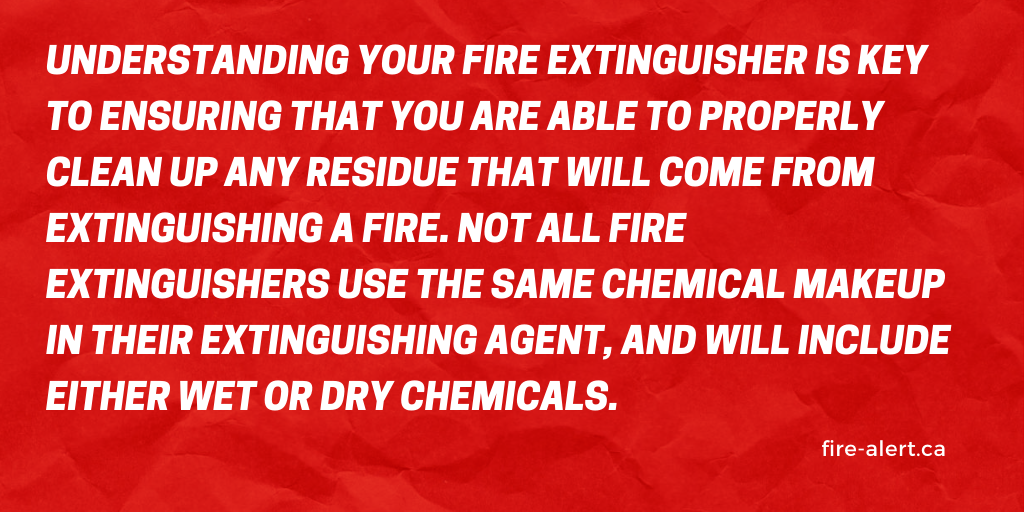How to Properly Clean up Fire Extinguisher Residue
Fire extinguishers are not only incredibly handy to have in the event of a small fire breakout, but they can potentially be lifesaving. The downside is that once the fire is completely extinguished, you’ll be left with a substantial amount of fire extinguisher residue. It’s important to know how to clean up this residue for a variety of reasons – firstly, you’ll be able to assess the real damage to your home underneath the fire extinguisher residue. You’ll also be able to minimize potential respiratory irritation, which can be caused by the ammonium phosphate and ammonium sulfate powder that are often found in ABC fire extinguishers. In this article, we explain how to properly clean up fire extinguisher residue, so you can know the proper procedure regardless of the type of extinguisher.
Understand Your Fire Extinguisher

Understanding your fire extinguisher is key to ensuring that you are able to properly clean up any residue that will come from extinguishing a fire. Not all fire extinguishers use the same chemical makeup in their extinguishing agent, and will include either wet or dry chemicals.
Fireline.com expands more on why it’s important to understand the chemical makeup of your fire extinguishing agent:
“Before starting any cleanup, you must identify the chemicals used as an extinguishing agent. All fire extinguishers have a tag or label which identifies the type and class of extinguishing agent. Agents could include water, dry or wet chemicals, foam or Carbon Dioxide (CO2). Pressurized water fire extinguishers or CO2 fire extinguishers will not leave chemical residue. Drying the area to remove any lingering moisture is all that is necessary. If foam fire extinguishers are used, any residue should be diluted and dried thoroughly. You can sanitize those areas or spot clean any remaining residue,if needed. They might even need more intensive cleaning.”
Cleaning Fire Extinguisher Residue from a Dry Chemical Extinguisher
Dry chemical extinguishers can be used for class A, B, and C fires and are therefore the most common and most versatile fire extinguishers as they can put out class A, B, and C fires. However, these types of fire extinguishers contain fire fighting agents like monoammonium phosphate, sodium bicarbonate, and potassium bicarbonate, which leave behind a corrosive powder. Not only can this powder be potentially damaging to your respiratory system, but it can also cause damage to electronics and metal surfaces if left to sit.
FireSystems.net explains how to safely and effectively clean up fire extinguisher residue from a dry fire extinguisher:
-
Vacuum or sweep up as much of the excess residue as possible
-
Mix together a solution of 50% isopropyl alcohol and 50% warm water then spray the area to break up the leftover silicone. Let the solution settle for about five minutes then rinse the area using warm water.
-
To treat sodium bicarbonate and potassium bicarbonate based dry chemicals, mix together a solution using 98% hot water and 2% vinegar and wash the area with it. Let the solution settle for about five minutes then rinse the area using warm water.
-
To treat monoammonium phosphate based dry chemicals, mix together a solution using hot water and baking soda. Let the solution settle for about five minutes then rinse the area using warm water.
-
Wash and rinse the area with a solution made of soap and water.
-
Use a fan to spot dry the wet areas.
Cleaning Up Wet Chemical Residue
Wet chemical fire extinguishers are most often used for class K fires. Class K fires are those that are fueled by flammable liquids that are unique to cooking, such as cooking oils and greases. Although easier to clean than dry chemical extinguishers, there are extra precautions that should be taken while doing so.
Koorsen Fire & Security expands on the potential dangers of cleaning up wet chemical residue:
“Class K wet chemical fire extinguishers are used in commercial kitchens to fight cooking fires. These extinguishers use a wet mixture of alkaline chemicals such as potassium carbonate, potassium acetate, or potassium citrate that turns into a foam, which blankets the fire depriving it of oxygen. Because this type of extinguisher is used primarily in commercial kitchens and around cooking appliances, one of the most important steps is to turn off all power to any equipment prior to cleaning it. Make sure everything is completely dry before turning any power back on for any appliance.”
Fire-Alert takes pride in equipping homeowners with all necessary fire safety devices to ensure the well-being of families across the nation. Reach out to us using our contact form to find out more.